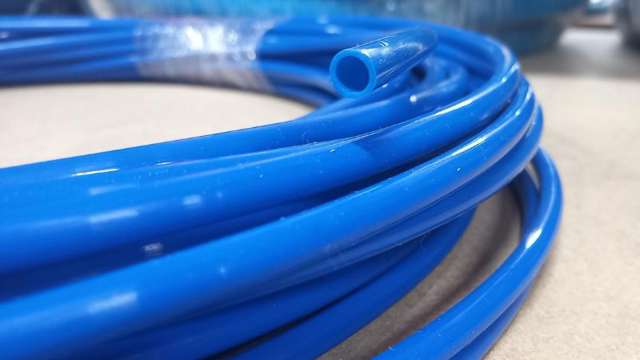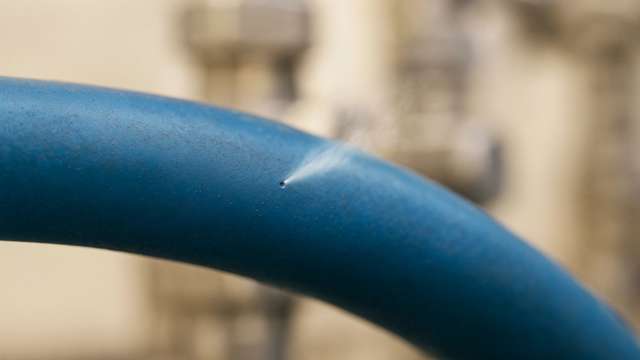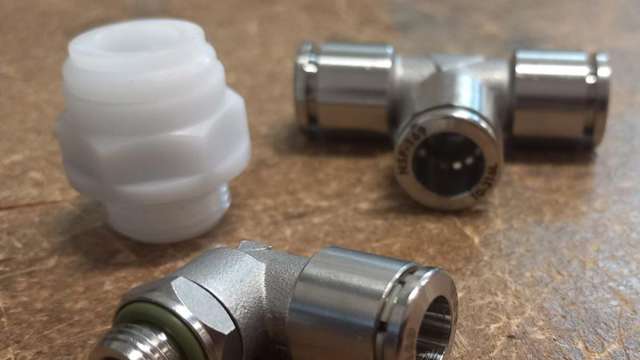Compressed air is an indispensable part of many process plants. For example, it drives actuators, controls valves and ensures that systems respond accurately and quickly. But behind the seemingly steady flow of air, there’s often a hidden problem: leaks. Especially in installations where materials such as plastic are used for hoses and fittings, the ravages of time, vibrations and repeated loads can lead to microscopic leaks that are costly in the long run.
This is where Teflon hoses and push-in fittings come in. They provide a simple yet effective solution that can make a noticeable difference in both reliability and energy consumption. In the following, we take a closer look at three key reasons why this combination is worth considering in your compressed air installation.
1. Teflon holds tight – and lasts longer

Teflon – also known as PTFE – isn’t just an alternative to plastic. It’s a material with significantly higher resistance to pressure, temperature and chemical influences. In compressed air installations, which typically operate at 6-8 bar, it’s crucial that the hoses can withstand the constant loads without giving way.
Plastic can be a fine and economical material in many applications, but over time it can become porous. The result? Microscopic leaks that are almost impossible to see – but which slowly drain the system of energy and pressure. A tiny crack, a crack in the surface, and the compressed air starts to leak out. It can take weeks – maybe months – before anyone notices. But the energy loss starts right away.
PTFE hoses are far more stable under load. They retain their tightness even at high temperatures and chemical exposure, and they don't deform as easily with repeated connections and disconnections. In practice, this means fewer replacements, less maintenance and more stable operation. It's not just a technical improvement – it's also a financial gain.
2. Push-in fittings ensure flow – and make installation simple

Compressed air installations are often compact and complex. This is where fittings play an important role – not only in terms of tightness, but also in terms of space, flexibility and maintenance. Push-in fittings excel at combining simplicity with efficiency.
For the most commonly used hose dimensions – typically 6 or 8 mm – both standard couplings and push-on fittings with internal nozzles can in principle be used. However, they often restrict the flow, especially for longer hose lengths. Push-in fittings, on the other hand, are designed to be mounted on the outside of the hose and are easily connected via an internal lock ring that grips the hose and can be easily released with a single pressure. Push-in fittings provide a freer flow and thus better flow.
The built-in gasket in Viton® ensures a high level of tightness – even with vibration and pressure variations. At the same time, installation requires no tools or special training. A technician can quickly install or replace a fitting without major intervention in the installation. This makes push-in fittings a practical solution, both in construction and operation.
A good example of use is the connection between compressor and actuators. But that is far from the only application. Push-in fittings are suitable for a wide range of tasks in compressed air systems – from food production to pharmaceutical processes where hygiene and reliability are paramount.
3. The right material makes a difference to operating economy
When it comes to push-in fittings, it's not just about fit. The choice of material has a direct impact on durability, safety and cost. We typically distinguish between POM and stainless steel.
- POM (polyoxymethylene): A lightweight and economical material that works well in dry and clean environments where there are no high temperatures or aggressive cleaning agents. POM is ideal for simple compressed air applications where the installation isn’t exposed to high loads.
- Stainless steel (acid-proof AISI 316): The obvious choice when the installation needs to withstand chemicals, pressure, cleaning and mechanical impact. In areas with high hygiene standards – for example where fittings are close to production zones – it’s often necessary to choose materials that can withstand CIP cleaning and don’t degrade over time.
To sum up: POM is ideal for simpler compressed air applications where there are no high demands on robustness. However, if you are dealing with acidic or alkaline liquids, for example in CIP cleaning, or production conditions with higher working pressures, stainless push-in fittings are the way to go as they are more resistant and flexible. This means fewer replacements, higher reliability, and lower total costs – even in complex systems with many connections.
Example: Over 150 USD in energy loss per month for one hose

It may sound like nothing: A microscopic hole of just one millimeter in a compressed air hose. But the consequences are anything but small.
At an operating pressure of 7 bars, such a hole can leak up to 85 liters of air – per minute. Over 24 hours, that adds up to over 122,000 liters – or 122 m³ of compressed air. And it happens without anyone necessarily noticing. Because air is invisible. No puddles on the floor. No dripping. Just a constant loss that the compressor struggles to compensate for.
Compressed air isn’t free. On the contrary, it’s one of the most energy-intensive utilities in many businesses. It costs electricity to compress air and according to technical standards, energy consumption is typically 0.1 kWh per m³ of air. With a leakage consumption of 122 m³, this equates to around 12 kWh per day. Over a month? More than 350 kWh. And with an electricity price of e.g. 0,45 USD per kWh, the bill quickly adds up to over 150 USD.
All for a hole you can't see – and in a system that on the surface works as it should. But the energy is leaking out, slowly but surely. And it gets expensive in the long run.
Our product recommendations

When it comes to compressed air, there’s rarely a one-size-fits-all solution. But some products stand out as particularly well suited to the challenges we've described here.
- Teflon hoses: Our Teflon hoses are flexible, pressure resistant and resistant to temperature and chemical influences. Perfect for compact compressed air installations where reliability is essential. We supply smooth Teflon hoses in most dimensions.
- Push-in fittings in acid-proof stainless steel: A durable solution for demanding environments where hygiene and mechanical strength are key. Stainless push-in fittings are ideal for CIP environments, vibration-prone areas or high stress locations.
- Push-in fittings in POM: A good choice for simpler compressed air applications where conditions are stable and requirements are moderate. POM push-in fittings provide an economical and easy-to-use alternative for smaller installations.
Avoid hidden leaks and unnecessary costs
Small leaks can grow big – not physically, but financially. A tight compressed air installation isn't just about good engineering, it's about securing operations, reducing energy consumption and avoiding hidden costs. Choosing durable materials, smart connections and dimensions that match the job can go a long way. It doesn't have to be sophisticated – it just requires the right choices from the start.
Want to secure your compressed air installation against energy waste and downtime? Then contact us for advice. We'll help you find the solution that holds tight – and lasts in the long run. Contact us via inquiry@alfotech.eu or call us on +45 7020 0422.
 da
da
 de
de
 en
en
 sv
sv
